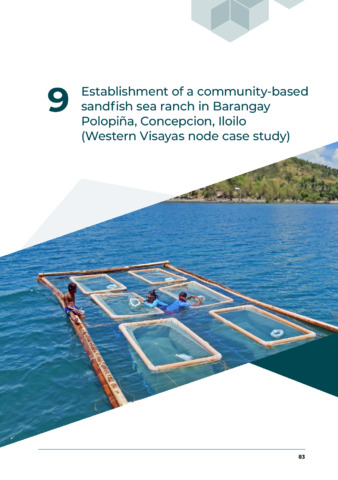Perlihatkan publikasi sederhana
Status of sea cucumber fishery and populations across sites with different levels of management in Palawan, Philippines
| dc.contributor.author | Jontila, Jean Beth S. | |
| dc.contributor.author | Monteclaro, Harold M. | |
| dc.contributor.author | Quinitio, Gerald F. | |
| dc.contributor.author | Santander-de Leon, Sheila Mae | |
| dc.contributor.author | Altamirano, Jon | |
| dc.date.accessioned | 2018-09-17T01:51:05Z | |
| dc.date.available | 2018-09-17T01:51:05Z | |
| dc.date.issued | 2018 | |
| dc.identifier.citation | Jontila, J. B. S., Monteclaro, H. M., Quinitio, G. F., Santander-de Leon, S. M., & Altamirano, J. P. (2018). Status of sea cucumber fishery and populations across sites with different levels of management in Palawan, Philippines. Ocean & Coastal Management, 165, 225-234. | en |
| dc.identifier.issn | 0964-5691 | |
| dc.identifier.uri | http://hdl.handle.net/10862/3332 | |
| dc.description.abstract | This study was conducted to investigate the sea cucumber fishery and compare populations between exploited and unexploited sites. Three islands were selected, the Arrecife Island as the unexploited site and the Johnson and Green Islands representing the exploited sites. In each site, sea cucumber species richness, diversity and densities were assessed by laying as much as 15 transects (50 m × 5 m) per habitat in each island. Differences in species richness, diversity and relative densities across sites and habitats were tested using a Two-way Analysis of Variance (ANOVA) and Tukey test for post hoc comparisons. An interview with gatherers, key informants and focus group discussions were also conducted to gather information on the sea cucumber fishery and its management. Results showed that the unexploited site had a higher species richness (14 vs. 7 and 7). Relative density of species was also higher in the unexploited site at 1245 ind ha-1 while it was only 78 and 39 ind ha-1 in exploited sites (p < 0.05). Interviews and a focus group discussion revealed that national regulations on permit system and size limits were not enforced at the local level and that gatherers had low levels of awareness regarding regulations on sea cucumber harvest. Current management measures appear to be ineffective and insufficient, leaving the sea cucumbers in areas open to exploitation at risk of depletion. Given that sea cucumbers provide substantial income to local communities, the depletion of this resource could compromise the livelihood of people in island communities that rely heavily on marine resources for living. Thus, this study highlights the need to review national policies on sea cucumber fishery and place the management at the local level. | en |
| dc.description.sponsorship | This study was jointly funded by the Department of Science and Technology- Science Education Institute (DOST-SEI), the University of the Philippines Visayas and the Western Philippines University. The support and cooperation of the Municipality of Roxas, Palawan, the management of Arrecife Island especially Ms. Glesselle T. Batin, and the sea cucumber gatherers in Green and Johnson Islands are greatly appreciated. | en |
| dc.language.iso | en | en |
| dc.publisher | Elsevier | en |
| dc.subject | species richness | en |
| dc.subject | sea cucumbers | en |
| dc.subject | Philippines | en |
| dc.title | Status of sea cucumber fishery and populations across sites with different levels of management in Palawan, Philippines | en |
| dc.type | Article | en |
| dc.identifier.doi | 10.1016/j.ocecoaman.2018.08.025 | |
| dc.citation.volume | 165 | |
| dc.citation.spage | 225 | |
| dc.citation.epage | 234 | |
| dc.citation.journalTitle | Ocean and Coastal Management | en |
| dc.subject.asfa | biodiversity | en |
| dc.subject.asfa | species diversity | en |
| dc.subject.asfa | fishery management | en |
| dc.subject.asfa | sustainability | en |
| dc.subject.asfa | sea cucumber fisheries | en |
Files in this item
| Files | Size | Format | View |
|---|---|---|---|
|
There are no files associated with this item. |
|||
Publikasi ini ada di koleksi berikut
-
Journal Articles [1256]
These papers were contributed by Department staff to various national and international journals.




